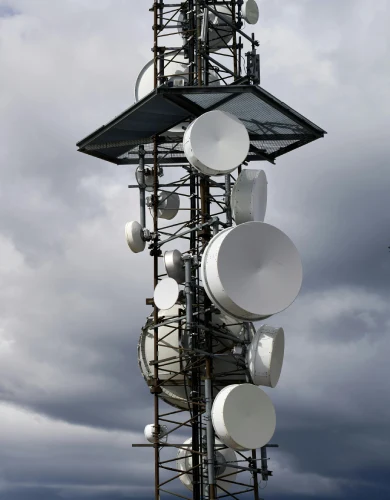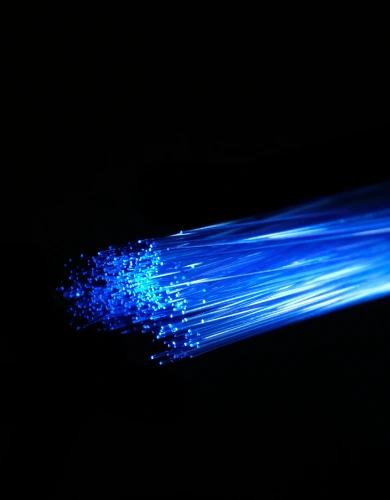How fibre optic broadband works
Fibre optic technology has transformed the UK’s internet infrastructure, delivering faster, more reliable, and higher-capacity broadband.
Without the fibre optic revolution, remote working, video conferencing, and streaming services like Netflix would not have been possible.
This guide explains the use of fibre optic broadband technology in the UK. Here’s what it covers:
- What are fibre optics
- How does fibre optic broadband work?
- Types of fibre optic broadband
- Fibre optic broadband performance
- Fibre optic broadband speed
- Fibre optic broadband installation
- Fibre optic network providers
What are fibre optics
Fibre optics are extremely thin strands of glass or plastic that carry data using light signals.
Each fibre is about as thin as a human hair, yet it can transmit vast amounts of data at the speed of light.
Before the introduction of fibre optic broadband in 2010, ADSL broadband was widely used in the UK. This relied on the copper-wire landline network to transmit broadband data.
Fibre optics offer a vastly superior method for transmitting broadband data packets compared with copper telephone cables because:
- Light signals travel much faster through glass than electrical signals through copper, significantly reducing latency.
- Light signals support a wider range of frequencies, enabling a higher data throughput rate on a single fibre and increasing connection speeds.
- Light experiences significantly less signal degradation than electrical signals through copper, ensuring more consistent performance.
Fibre optic technology is so clearly superior to ADSL that the copper-based landline network is being shut down in 2027 as part of the big switch off.
How does fibre optic broadband work?
All internet activities, such as using a VoIP phone system, watching a YouTube video, or sending and receiving emails, require data to be transferred between your device and the internet.
This section provides a step-by-step explanation of how a fibre optic broadband connection facilitates data transfer from the wider internet to your device.
This process works equally in both directions, facilitating uploads and downloads, but we’ll describe the download direction.
Conversion of data into light signals
An internet service provider, such as Openreach, receives your request to send data (such as loading a web page) at a local exchange.
The local exchange receives the digital data, in the form of a series of 1s and 0s, from the wider internet and converts it into light pulses for transmission through a fibre optic cable towards your property.
Each pulse of light represents a binary value (light on = 1, light off = 0).
Transmission of data through a fibre optic cable
The light signals produced at the exchange travel through fibre optic cables from your local exchange towards your property.
The distance covered by the fibre optic cable from the exchange is typically between 10 and 20 kilometres.
The light travelling through the fibre cable continuously reflects off the inner walls of the cable in a process called total internal reflection.

Source: BBC Bitesize
Fibre optic cables are extremely efficient at transmitting light signals, so amplification during the journey is typically not required.
Passive optic splitting
Most fibre broadband infrastructure providers in the UK use a passive optical network design for their fibre broadband.
This means that, near your property, the fibre optic cable is split into up to 32 separate connections, dividing the light signals equally between multiple customers in your local area.
The data included in your web page load is sent to all nearby properties; however, it is labelled in such a way that only your Optical Network Terminal recognises and processes your data.
💡 This step does not occur in leased line broadband. A leased line is a form of uncontended broadband and does not share the fibre optic cable with other nearby properties, enabling much higher speeds.
Conversion back to an electrical signal
At the end of the fibre optic cable, the light signals are converted back into electrical signals by an Optical Network Terminal (ONT).
The ONT utilises semiconductor devices known as photodetectors, which respond to incoming light signals and convert them into an electrical current.
The electrical signal is then fed into either:
- A business broadband router, for full fibre broadband.
- A copper phone line cable for short distances in part-fibre broadband, which then connects to a router.
Devices in the property receive internet data either by connecting wirelessly to the router or by plugging in with an Ethernet cable.
Types of fibre optic broadband
Our explanation of how fibre optic broadband works broadly applies to all types of fibre optic business broadband. However, there are four distinct types of widely available fibre broadband services in the UK that we’ll explain here.
Part fibre/SoGEA broadband
In a part-fibre broadband connection, the fibre optic cable terminates at the nearest Openreach street cabinet.
The internet data is then transmitted from the cabinet to the customer using the copper landline installed in most older buildings.
The short distance travelled through the copper cable significantly limits the speed of SoGEA broadband, providing a maximum speed of 80 Mbps.
Find out more in our full guide to SoGEA business broadband.
Cable broadband
Cable broadband is a part-fibre broadband product offered exclusively by Virgin Media business broadband.
Instead of relying on copper landline cables, a high-performance coaxial cable is used for the final mile of the connection. This coaxial cable technology increases the available speeds to up to 1 Gbps.
Find out more in our guide to cable broadband.
Full fibre
Full fibre is a Fibre to the Premises (FTTP) connection type, where the fibre optic cable terminates at an Optical Network Terminal within the customer’s building.
Full fibre business broadband is not slowed down by transmission through copper cables, enabling speeds of up to 1.6 Gbps.
Openreach and other alt-nets are expanding their full fibre coverage across the UK, and it is now available to approximately 70% of properties.
Find out if full fibre is available in your area by visiting our business broadband availability page.
Leased line broadband
Leased line broadband provides a dedicated fibre optic cable connecting a single business directly to the exchange.
Since the fibre cable is not shared with other nearby users, leased line speeds of up to 10 Gbps are available.
Leased line broadband installation requires the laying of a new, dedicated fibre optic cable, making leased line prices significantly more expensive than other broadband types.
Find out more about leased line technology in our guide on how leased line works.
FTTP vs FTTC
Two acronyms, FTTP and FTTC, describe fibre optic connection types for Openreach fibre services. Both refer to how individual premises are connected to the nearest Openreach cabinet.
- Fibre to the Premises (FTTP): A dedicated fibre optic cable connects premises directly to the exchange. This is typically advertised as full fibre.
- Fibre to the Cabinet (FTTC): A copper phone line connects premises to the cabinet. This is typically advertised as part fibre, standard fibre, or SoGEA broadband.
The key difference lies in the performance of the cable in the “last mile” of the broadband connection.
A copper phone line has a maximum bandwidth of 80 Mbps, severely limiting the speed of an FTTC connection, whereas FTTP can be up to twenty times faster by utilising high-performance fibre optic technology.
Fibre optic broadband performance
Fibre optic technology makes broadband highly reliable and secure. In this section, we explain the key performance advantages of fibre optic broadband.
Fibre optic broadband reliability
Fibre optic broadband connections are the most reliable form of broadband available in the UK.
Fibre broadband offers three key advantages that contribute to its high reliability:
- Light signals in fibre optic cables are immune to electromagnetic and radio interference.
- Unlike copper cables, fibre optic cables do not corrode over time.
- Fibre optic cables maintain signal strength over long distances, reducing reliance on signal amplification equipment.
For more information, refer to our full article on business broadband reliability.
Fibre optic broadband security
Fibre optic broadband has intrinsic characteristics that make it more secure than copper or wireless connections.
The light signals traversing fibre optic cables are encrypted and require specialised equipment to decode. Furthermore, any attempt to tap into fibre optic cables causes a noticeable disruption in the light signals, making unauthorised access easily detectable.
For more information, refer to our full article on business broadband cybersecurity.
Fibre optic broadband speed
Long-distance fibre optic cables can support extremely high speeds with minimal loss and interference.
In June 2024, a laboratory in Japan achieved a speed of 402 terabits per second, which is five million times faster than the average broadband speed in the UK.
The data transfer efficiency of fibre optic cables is significantly greater than that of radio waves used by 5G business broadband or satellite business broadband.
The table below shows the maximum download and upload speeds of fibre optic broadband services in the UK:
| Type of fibre optic broadband | Max download speed | Max upload speed |
|---|---|---|
| SoGEA | 80 Mbps | 15 Mbps |
| Cable | 1 Gbps | 52 Mbps |
| Full Fibre | 1.6 Gbps | 115 Mbps |
| Leased Line | 10 Gbps | 10 Gbps |
For more information, visit our guide to business broadband speeds.
Broadband providers typically offer a range of speeds for each service to meet the needs of individual customers, with business broadband prices increasing in line with the speed of the service.
Fibre optic broadband installation
The process required for a business broadband installation depends on the technology used for the connection.
Here’s a summary of what is typically involved:
- Part fibre: Typically, no installation is required as it relies on existing copper landline connections already installed in most properties.
- Cable/Full Fibre: When first used, this option requires the installation of a new cable between the local cabinet and the individual property.
- Leased line: Installing a dedicated fibre optic cable from an exchange to the property is always required. For more information, read our guide on leased line installations.
For more information, visit our complete guide to business broadband installations.
Fibre network providers
In the UK, businesses and homes can choose from hundreds of competing broadband providers.
These domestic and business broadband providers rely on a small number of fibre optic network providers to manage the physical infrastructure.
The biggest fibre network providers in the UK are:
- Openreach (part of the BT group)
- City Fibre
- Virgin Media
- CommunityFibre
- Hyperoptic
Source: ISP Review network coverage.
These are further supported by regional fibre networks such as KCOM.

